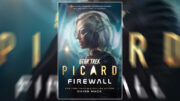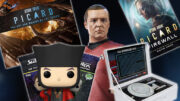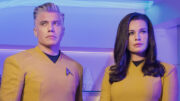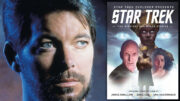Review: Star Trek: The Book of Lists
Written by Chip Carter
Published by Harper Design, an imprint of Harper Collins
Hardcover, 224 pages
In Star Trek future history, physical books are still around, although treated as a sort of novelty, like Michael Burnam’s copy of Alice’s Adventures in Wonderland. But are books already obsolete? Is there a need for a physical collection of information on Star Trek – a book of lists about captains’ romances, redshirt deaths and more – when the Internet lets us find all of that so quickly and easily?
This is the question posed by the just released Star Trek: The Book of Lists, written by Chip Carter, described as a “breathtaking collection of the most compelling Star Trek facts and trivia, including events from both on and off-screen spanning the 51-year history, available in 100 concise lists.”
Even just posing the question shows I’m a little cynical about the market for a book like this, but after reading it I can see the value. The Internet may be a vast ocean of information, but sometimes people would rather splash around in nice contained area. Enter Star Trek: The Book of Lists, which is a well-organized pool of Star Trek trivia.
The book is thoroughly researched and rich with information, both from on screen and off screen. It includes trivia from all of Star Trek on TV before Discovery, including The Animated Series as well as all the Kelvin-verse films.
Of the 100 lists contained the book, some favorite are:
- Particularly egregious technobabble
- Connections between TOS and the 1966 Batman series
- Pre-fame celebrity Star Trek appearances
- Fights at the Vasquez Rocks
- Twins, both evil and otherwise
- Times Captain Kirk got his shirt ripped
Carter also has a list of “best of” episodes from each series which are pretty hard to argue with, although it doesn’t include all 10 of Trek Movie’s best TNG episodes. I do take issue with his “worst of” episodes list which includes Voyager’s “The Thaw” – a standout which even cynical online reviewer SF Debris called “the best episode of Voyager’s first two seasons.” (But isn’t the best parts of lists, online and off, arguing about them? So, we won’t sick The Clown on him.)
And this book isn’t all trivia lists. For example, there’s a shot-by-shot detailing of the Picard Maneuver that at once makes you wonder why no one had thought of it before that one episode … and why no one ever talked about it after either.
The handy hardcover measuring 7″ by 9″ would comfortable fit on a coffee table or even in a bathroom (we all do it). Its cover is a sleek, futuristic silver with a TNG computer interface look. The full-color graphic design throughout is simple and straightforward with just the right amount of visuals.
So consider this cynic convinced, with Star Trek: The Book of Lists getting my recommendation. Even if you think you know everything there is to know everything there is to know about Trek, this book has some some surprises and is presented in a delightful format. And if someone wants a cursory introduction to the franchise, this book would make a wonderful present for Christmas, Hanukah, the non-Judeo-Christian yuletide holiday of their choice, or a even a fantasy Christmas in an extra-dimensional realm in which one’s thoughts and desires shape reality.
Available now
Star Trek: The Book of Lists, was released today, November 7th and retails for $25. You can get the hardcover edition on Amazon for $16.50. There is also an ebook version available for $15.21.













I honestly could never see physical books going obsolete. A book is an intimate and special thing to actually hold. It is different to simply looking at a tablet screen.
A book is something extra personal to oneself.
“The Thaw” was polarizing when it first aired. I remember usenet was about evenly split between those who thought it was great and those who thought it was terrible. There seemed to be little middle ground on that episode.
This book is… OK.
The Thaw sucked.
Physical books are such a hassle. You have to either go out to buy one, or wait for it to arrive in the mail. Then, you have to find a place to keep all of them, which gets progressively harder as you accumulate more books. If you want to read the book outside of your house, you have to schlep it around with you, and books are often heavy. Then, when you go to read them, you have to find a poace where the light is just right. If the text doesn’t come in the size that you want, there’s nothing you can do. You have to be careful to take good care of them, or they will fall apart over time.
Needless to say, I prefer e-books. I never read physical books any more if I can help it, but I’ve been readinf more than ever since I got my iPad.
Kindle/Nook/Kobo, sure. But reading long periods of time on an iPad? Ugh, my eyes! My eyes!
Anyway, novels are fine with eReaders, but nonfiction/reference books with lots of illustrations and tables are still best in print. By a wide margin.
But you don’t need to reboot paper, or charge it. If the power goes off you can still read by candle or flashlight. You can’t accidentally delete a physical book either.
Penguin44,
You obviously have been spared the sight of the decimation of personal libraries by sleeping nicotine addicts.
I am not an ebook fan..
I like something that I can hold and touch.
Gary 8.5,
I prefer a musty old tome too, but I’m not going to deny myself access to ebooks, audio books, speeding reading, etc. as the need arises for the drier stuff.
This seems more silly than obsolete.
It’s certainly NOT accurate. The Enterprise TOS filming model was used for different ships (but they were all labeled Enterprise as none of them shown their different NCC hull numbers. Constellation did only because it was a model kit itself) but usually as distance stock film… and the Reliant Film model was used for many different classes… seems to me like it’s just a cash grab, rather than a good product for Christmas
~Pensive’s Wetness
Speaking of Trek lists, looks there’s a possibility of a type of supernova that could be used to play with Trek physics:
“This supernova [iPTF14hl] breaks everything we thought we knew about how they work. It’s the biggest puzzle I’ve encountered in almost a decade of studying stellar explosions.” — Iair Arcavi, a postdoctoral fellow at Las Cumbres Observatory (LCO) who is based in California.
“According to this theory [Pulsational Pair Instability Supernova], it is possible that this was the result of star so massive and hot that it generated antimatter in its core.” — Daniel Kasen, from the University of California, Berkeley.
“For now, the supernova offers astronomers their greatest thrill: something they do not understand.” — Prof Stan Woosley, from the University of California, Santa Cruz
I’ve found, as an avid Kindle reader of some years, that I’m moving back increasingly to regular books. I find non-fiction, in particular, is better to read in a ‘dead tree’ medium. I don’t mind ‘easy read’ novels, such as Spillane’s or Robert B Parker’s books, on a reader, but history books and biographies are so much better on paper.
However, I also find that giant ‘doorstoppers’ such as The Count of Monte Cristo or the work’s of James Clavell and Ayn Rand are better on a reader than paperbacks because they’re easier to carry around and I can read them in a larger type size.
But a book of lists is unquestionably best in a real physical form, plus it looks like it’s lavishly illustrated, so I want to see the photos.
I suspect, as time goes by, fiction paperbacks will fade away in favour of downloading, but there’ll always be a demand for atlases, coffee table books manuals and history books.
This book appears to be rather pointless. It’s not even trivia, it’s random, incomplete trivia. Who is the target audience for that book? Also, for lists like “remade” or “remodeled”, I smell some copy/paste work from memory alpha or ex-astris-scientia.org, who did a fantastic job researching this kind of stuff.